|
 From the From the
Executive Chair
We are used to getting the annual report in book form at May's annual meeting, so a few of you have wondered where the report is. The Guild of Volunteers' executive committee has changed the report's publication date because our fiscal year has changed. The year now runs from July 1 to June 30 each year, which matches the museum's fiscal year. This made sense for many reasons, the most important being our budget; volunteer hours and statistics will now mesh efficiently with those of the museum. This is more accurate and avoids the calculations previously needed to make sure we were working with the correct numbers and time periods.
The guild's executive committee took a hard look at the form of our annual report and determined the relevant information could be conveyed in a more condensed and informative package. Historical information repeated annually has been archived. It has not been deleted or lost, but rather saved in another accessible form. The annual report will be sent out electronically, but hard copies will be mailed upon request. The guild owes a special thank you to Judy McKenna and Pauline Bogaert who not only produce our superb newsletter, but who have worked diligently to help streamline the annual report while ensuring that it contains all of the relevant information for the year just completed. We hope you agree. Our goal is to make it an annual report and not an archival document.
Another area in which you will see change is in logging volunteer hours. Each of us has been logging volunteer hours faithfully on the computer program set up some time ago. It came as a bit of a surprise to a number of us how inconsistent the actual logging of hours has been. In an effort to correct those inconsistencies, we formed a "Guild of Volunteers Task Force on Methods and Recorded Data for Logging Volunteer Hours." It's a long name for a very efficient group headed by Ted Parrot. The problem was not if volunteers were logging their hours, but how they were calculating time spent for routine duties such as tours, field trips and travel time. Sometimes a new class of volunteers was given one set of instructions for logging their hours, while the next class received slightly different instructions. The changes will now show the entered hours more accurately reflect the actual task and time spent. Chargeable and non-chargeable hours will also be defined.
You will already have noticed there are more categories to log your hours than before. It is not simply "tour/non-tour" anymore, but it now reflects the many duties volunteers help with throughout the museum and art center. The new categories Library, Assisting Museum Staff and Special Projects are self-explanatory, but if you have concerns about other categories please let us know.
If you are not sure which category to enter hours for a specific task, enter it under "other" and Kim Tyndall will get back to you if it was properly logged or not. This tool will help the museum in writing grant applications and determine how many paid staff hours are saved through our volunteer efforts. To be sure the new system flows seamlessly; you will soon receive easy-to-follow instructions. Thank you for your patience and for your commitment to the museum.
|
|
Guild of Volunteers
Annual Report
2010-2011
Click here |
|
 The Book Shelf The Book Shelf
What Jane Seney is reading...
One of the books I enjoyed over the summer was called At Home: A Short History of Private Life by Bill Bryson. The author has a wonderfully curious mind and in this book explores why things 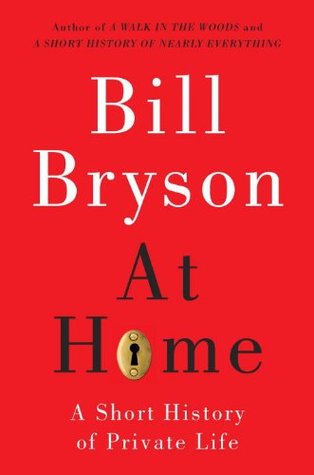 are the way they are in homes - everything from the history of furniture design (what does "board" mean in the phrase "room and board"?) to the reason, out of all of the spices in the world, we've decided salt and pepper should be the staples for every table top. In telling these histories, Bryson includes fantastic tales and factoids throughout. He writes, "Houses aren't refuges from history. They are where history ends up." are the way they are in homes - everything from the history of furniture design (what does "board" mean in the phrase "room and board"?) to the reason, out of all of the spices in the world, we've decided salt and pepper should be the staples for every table top. In telling these histories, Bryson includes fantastic tales and factoids throughout. He writes, "Houses aren't refuges from history. They are where history ends up."
One of the book's delights is the way the author folds information from the fields of architecture and the fine arts. The book begins with an extensive examination of the Crystal Palace, a massive glass exhibition hall designed by Joseph Paxton in London in 1850. The building was an engineering marvel because upon its completion it was the biggest and lightest building in the world. Bryson uses it as an opportunity to discuss how glass has been used in houses since the Middle Ages, explaining the major determining factors for windows in homes were taxation on glass and the innovation of plate glass.
Throughout the book I enjoyed Bryson's amusing presentation of historical trivia and was in awe of his ability to show the interconnectedness of disparate places and times, tying everything back to the houses in which we live today. I would definitely recommend the book - you'll learn a lot and you'll enjoy it.

Jane Seney, Educator for Tour and Docent Programs 669-6144, x149
jseney@currier.org
|
|
Or, use the Guild Room computer the next time you stop in. |
 Karnes Show Catalog, Books and DVDs at Museum Shop Karnes Show Catalog, Books and DVDs at Museum Shop
The Museum Shop will be selling the catalog from the current exhibit, A Chosen Path: The Ceramic Art of Karen Karnes, which runs through the end of this year. Also on sale is the DVD, Don't Know We'll See; The Work of Karen Karnes.
In conjunction with the show, the shop has added a new line of artists' pottery wares.
The 2012 wall and engagement calendars are now in. Stop in soon to get the best selection.
The shop staff and long-standing volunteers would like to welcome two new volunteers to our ranks. Diane DiGirolamo and Patricia Reigstad have been volunteering in the shop lately. Please come by and welcome them to the Currier.
Always remember all guild members receive a 20 percent discount on shop purchases.
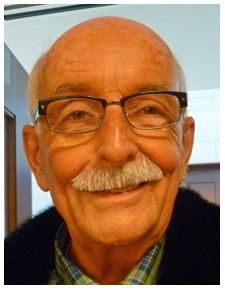
Richard Russell, Museum Shop Chair
606-2777
rrr1944@motleythebear.com
|
|
2010-2011
Executive Committee
Officers
Executive Chair:
Pat Howard
Executive Vice Chair:
Barbara Shepler
Treasurer:
Ted Parrot
Secretary:
Yvonne Dunham
Committee Chairs
Guild Ambassadors:
Frances Gray
Fran Wiggin
Guild Communications:
Judy McKenna
Pauline Bogaert
Guild Meetings & Programs:
Nancy Johnson
Guild Membership:
Kim Tyndall
Museum Docents:
Carolyn Hollman
Museum Shop:
Richard Russell
Special Projects:
Pam Parrot
Zimmerman House Docents:
Dennie Dyer
|
The Currier Guild in action enewsletter Staff:
Editors: Judy McKenna and Pauline Bogaert
Photo Editor: Anna Zhurbey
Blog Administrator: Karin Whitford
Production Assistance: Neva Cole, Michelle Pennington |
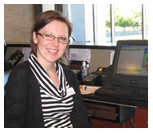 | | Photo editor Anna Zhurby |
|
|
Guild of Volunteers Blog
 | | Blog administrator Karin Whitford |
Join the conversation on the Guild of Volunteers latest blog post: "Technology - Does it Add to the Art Museum Experience?"
Click here. |
Currier Guild eNewsletters Archive
To view a previous eNewsletter, click on the desired link: |
Guild of Volunteers Handbook Online

Ever wonder about the history of the Guild? How the Guild board is structured? What the committees do? The Guild of Volunteers handbook is online with all the answers. To view the Guild Handbook, click here. |
|
|
Mark your Calendars:
Guild of Volunteers Semi-Annual Meeting
Wednesday, November 8, 2011 Details to come |
|
|
Guild of Volunteers 2011 Annual Meeting/Spring Lunch Photo Slide Show: click here |
Inspired Words Led by Docents September 11
The Currier Museum 's Inspired Words program coordinated by Kim Tyndall and Jean McGiffin will present a special afternoon of readings at 2 p.m. Sunday, September 11. On the 10th anniversary of the 911 attacks, writers from around the area have been invited to give their thoughts and writings on the events of that fateful day. 's Inspired Words program coordinated by Kim Tyndall and Jean McGiffin will present a special afternoon of readings at 2 p.m. Sunday, September 11. On the 10th anniversary of the 911 attacks, writers from around the area have been invited to give their thoughts and writings on the events of that fateful day.
The museum, which opens at 11 a.m. and closes at 5 p.m., will have free admission. |
|
Spotlight
Vancouver's Loss is Manchester's Gain
Pat Howard moved to New Hampshire in 2000, and in the ensuing 11 years this Canadian dynamo has cemented her footprint in our town's social streets.
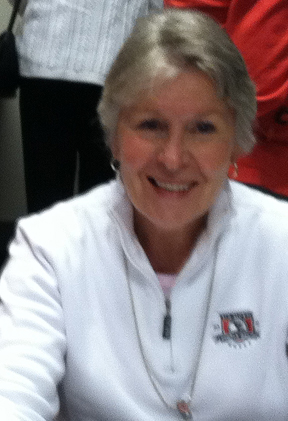 | | Pat Howard |
As co-president of the Friends of Stark Park, and since 2010 its president, the Friends, Manchester Parks and Recreation and other volunteers cleaned up the neglected historic site on River Road. She is a member of the Manchester Heritage Commission, and on the Historic Preservation Committee of the Manchester Historic Association. Best of all, Pat became involved with the Currier Museum of Art almost at once. In March, Pat moved from executive vice-chair to executive chair.
Her husband, Interventional Radiologist Don Logan, had a job interview for a medical position in Manchester. "We wanted a good airport, a big city nearby, Boston, with access to rural areas, and Manchester fit the bill," says Pat. During Don's interview, Pat was escorted to the Currier. "I was blown away by how good it was."
Shortly after they moved here, she signed up for art history classes with UNH Professor Andy Stangel and got to know Currier volunteers. She was encouraged to join the Currier guild. "It's one of the best things that I have ever done."
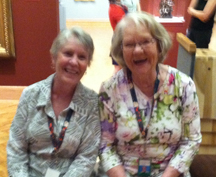 | | Pat Howard and Jane Bentas share a laugh at a recent meeting |
Pat was born at St. Paul's Hospital in Vancouver, British Columbia, the same hospital where she studied to become a nurse. She was a registered nurse there from 1967 to 1978. While still nursing, she completed her undergraduate and law degrees at the University of British Columbia. She worked for the Vancouver law firm Rankin and Company five years, leaving to start her own law practice specializing in medical/legal areas, family law and mediation.
In 1983, she met Don on a blind date, and they married in 1984. "We knew many people in common as Don interned at St. Paul's in 1979," she says. The couple moved in Canada and the U.S. while Don pursued specialization in the medical field. Pat continued law work when she could until 1996. "I thought I'd be in Vancouver my whole life, and never realized I would move so many times."
A fellowship for Don in Interventional Radiology took the couple to Philadelphia. Pat couldn't practice law due to visa restrictions, so "I signed up for everything I could." She taught a literacy training course, took watercolor and landscaping design classes, and an old house seminar. Moves to West Virginia, Bethlehem, Penn., and Vancouver followed before they finally landed permanently in Manchester.
Pat says being a Currier docent is like "getting a master's degree." At times when she's reading the New York Times, or other publications, she's amazed at how much she understands about certain art subjects, a result of the great knowledge she's gained being at the Currier.
Pat's favorite piece at the Currier is the 1925 painting by John Singer Sargent Grace Elvina, Marchioness Curzon of Kedleston. Jane Bentas and Pat lead a February love tour that includes this painting. "I love the look on her face," Pat says, wondering if she's sad, wistful or bored. "Mostly I like her story and her friendship with Sargent. I love the history of it all. Her husband could be difficult, sort of pompous, but from her book and his letters you can tell they had affection for each other."
Pat, a member of the Currier's Advisory Council and Development Committee and a past member of the Capital Campaign Committee that raised funds for the museum's latest addition, is "dazzled" by the early directors for the art they bought and how they built the collection.
"I've always had this artistic part of me," says Pat, who liked her careers in nursing and law. "In the profession of nursing and law people are in those places under pressure, but people come to the Currier because they want to be there."
Spotlight by Pauline Bogaert
|
Z-House Docent Report
 You be the Judge You be the Judge
Frank Lloyd Wright viewed himself as the most advanced and accomplished modern architect in the world. He also felt he had been overtaken by a younger generation of European modernists whose work he believed had stemmed from his own. Frank Lloyd Wright defensively condemned the austere, steel and glass structures produced by Walter Gropius and the International Style of architecture as grim, impoverished, unlivable and destructive to individuals. However, docents visiting the Walter Gropius House found something quite different.
 | | The Gropius House |
The Gropius House was the family residence of noted architect Walter Gropius (1883-1969) and is now owned by Historic New England. It was declared a National Historic Landmark in 2000. Gropius was a founder of the Bauhaus School of Design and one of the most influential architects of the 20th century. This house was his first architectural commission in the United States when he came to teach at Harvard University's Graduate School of Design. The home Gropius built for his family had a dramatic impact on American architecture. It was an early and prominent example of what Americans, to Gropius' dislike, called the new International Style. It's detailing keeps strongly to the principles of the Bauhaus.
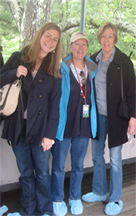 | | Blue-bootied Z-house docents Dennie Dyer and Nancy McGaan with Jane Seney at the Gropius House |
Modest in scale, the house was revolutionary in impact. It combined the traditional elements of New England architecture - wood, brick, and fieldstone - with innovative materials rarely used in domestic settings at that time, including glass block, acoustical plaster, chrome banisters, and the latest technology in fixtures.
The house is designed and detailed to work almost theatrically as a whole. The minimalist color scheme is maintained throughout the house - black, white, pale grays and earth colors - with sparsely used contrasting splashes of red. Striking as it is, the house was built with economy in mind, and total construction costs were $18,000.
In keeping with Bauhaus philosophy, every aspect of the house and its surrounding landscape was planned for maximum efficiency and simplicity of design. The house contains a significant collection of furniture designed by Marcel Breuer, which was fabricated in the Bauhaus workshops. Artwork includes personal gifts by Josef Albers, Joan Miró and Henry Moore. With the family's possessions still in place, the Gropius House has a sense of immediacy and intimacy. 
Dennie Dyer,
Zimmerman House Docent Chair
434-8794
dennie.dyer@comcast.net |
|
Museum Docent Report
 Farewell Summer, Welcome Fall Farewell Summer, Welcome Fall
After the guild's annual meeting, docents enjoyed a rich summer schedule including Nina Gara Bozicnik's introduction to the special exhibit Shifting Terrain in June, followed by a walk-through in July. Museum docents joined Z-House docents for a tour of the Gropius House in Lincoln, Mass., and there was a preview talk with Jane Seney about the recently arrived Virgin and Child with a donor, Sts James, John the Baptist, Nicolas and Anthony Abbott by Niccolò di Pietro Gerini on loan in the European Gallery.
Jane has prepared an exciting fall
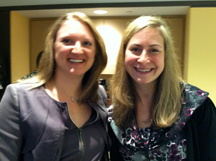 | | Nina Bozicnik and Jane Seney at the Shifting Terrain walk-through |
schedule of twice-monthly docent trainings. The fall schedule includes two new exhibits. Opening Aug. 27 is A Chosen Path: The Ceramic Art of Karen Karnes with a walk-though and video training session scheduled for Aug. 30. A workshop on Karen Karnes is set for Sept. 27. For information on the artist, click on Karen Karnes.
Opening on Oct. 7 is Backstage Pass: Rock and Roll Photography. Docent training will begin on Sept. 14 with an introduction from Portland Museum of Art curator Tom Denenberg (The PMA organized the exhibition in 2009). On Oct. 11 there will be a walk-through with Nina.
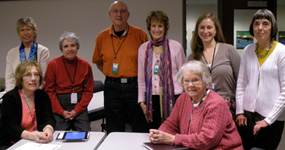 | | Docent Steering Committee members (l to r): Nancy Johnson, Ann Richardson, Nancy Baker, Alan Slotkin, Carolyn Hollman, Jane Bentas, Jane Seney and Carol Tingleff |
At the end of June, the Docent Steering Committee, which meets every month, reviewed the results of the year-end Museum Docent Training Survey. Docents who responded were overwhelmingly positive about last year's roster of trainings. High on the list were field trips (and the willingness of docents to pay outing costs in order to have more trips throughout the year). A sub-committee, headed by Carol Tingleff, will work on planning additional trips.
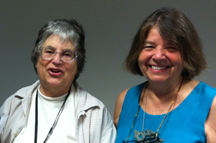 | | Theia Fischer and Judy Ransmeier at a recent docent meeting |
Also on the survey, comments about "what is working well with docent trainings" reflected great enthusiasm for Jane's presentations; sessions with curators and staff; and the variety of programs and opportunities for learning.
A large majority of survey respondents preferred to give feedback about trainings through an email survey, such as the one used the last two springs. Docents also liked the idea of an anonymous suggestion box. Look for the new "Question Box," which Jane will bring to all our meetings. Jane will provide a provocative question at meetings for docents to consider. Everyone is encouraged to provide feedback on any topic and place notes in the box. Jane, Christa Zuber, and the steering committee welcome all comments about your experiences as a docent. The steering committee members are Nancy Baker, Jane Bentas, Carolyn Hollman, Nancy Johnson, Ann Richardson, Allan Slotkin, and Carol Tingleff.

|
View Museum and Z-House Training Calendars On-Line:
Docent Calendar Z-House Calendar |
|
Welcome New Guild Meetings and Programs Chair Nancy Johnson

Nancy Johnson, our new Meetings and Programs Chair, is a woman of many talents and will be a welcome member of the guild's executive committee. Nancy and husband Bob, who is a Z-House docent, have three children and are the proud grandparents of six grandchildren. The Johnsons have lived in Bedford for 19 years and love to travel.
Nancy has a bachelor's degree in Mathematics from Northeastern University, and a master's degree in Computer Science from Pace University. She worked in research and development at Massachusetts Institute of Technology, and in computer programming graphics, editing and cartography. An excellent artist, after her retirement from the computer world she turned her avocation as an artist to a full-time vocation. Nancy's medium of choice is pastels, although she has worked in other mediums. As the past director of the Manchester Artists' Association Gallery on Elm Street, Nancy is well-versed in hanging shows and dealing with the details that go into showing works of art. In September, Nancy will become president of the New Hampshire Pastel Society.
Nancy, a docent for five years, loves leading children's tours at the Currier. She is enthusiastic about how much the Currier means to her and how lucky we are to have this museum. When it was suggested we
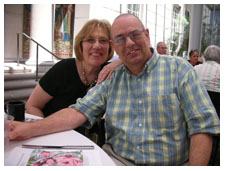 | |
Nancy and Bob Johnson |
think about a volunteers' art show at our Semi-Annual Meeting on November 8, Nancy jumped at the idea. So, get your artworks ready and give Nancy a warm welcome in her new position.
Peg Case stepped down as Meetings and Programs Chair. A special thank you goes to Peg for a job well-done.
-Pat Howard |
|
 Guild Membership Report Guild Membership Report
We're Making Changes
It has been a busy start to the 2011-2012 for the membership committee. We have been making many changes to the database where we record our hours and maintain volunteer information.
First, the guild board made the decision to change the categories where we record our volunteer hours. We expanded our list from two to 10 categories, which you should all be using by now. The finer breakdown of our contributions helps the museum with grants and with staffing decisions. If anyone isn't seeing the correct list, please let me know.
Second, a task force once again addressed the issue of how many hours volunteers should be recording for different jobs. Ted Parrot, who headed up the task force, will provide more details about the process and results of the task force's work. However, one result affects the hour's database: the end of doubling tour hours. This simplifies our work immensely. Since Aug. 1, tour hours are no longer doubled.
Third, we are awaiting a computer upgrade for the Guild Room (might be completed by press time). Our current system is a bit old and the upgrade will provide additional features, such as sound and improved speed.
Last, but most important, the guild is embarking on a project to incorporate our volunteers into the museum's members database. This provides us an opportunity to include more information on each volunteer, such as particular interests and skills. You will hear more about this transition in the coming weeks.
Also coming this fall, the museum will be replacing our current volunteer badges with new ones. You will hear more at training sessions later. I hope everyone had a wonderful summer and I look forward to seeing everyone when training starts again.

|
|
 The Screening Room The Screening Room
Would you like your own personal list of all the films in the Guild lending library? Now volunteers can obtain their own list of the videos and DVDs available, as well as periodic updates as new videos are added to the library. The list can be obtained in one of three categories: 1) an index to the topics and titles of videos and DVDs; 2) an annotated list of the VHS-format videos; and 3) an annotated list of the DVDs. If you would like any or all of these lists, call Theia at 883-2102 or email her at maydr@localnet.com.
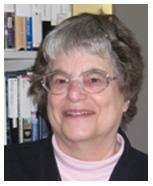
Theia Fischer,
Film writer
883-2102
maydr@localnet.com |
 Special Projects' Many Helpers Special Projects' Many Helpers
The Currier's summer events planned by Michelle Pennington, associate educator for adult and family programs, ran smoothly thanks to volunteer help given on Wednesdays throughout the summer by Carol Tingleff and Flo Fitzgerald.
Museum docent Jean McGiffin and Mary Carroll continue volunteering to help Meghan Petersen in the Currier's library. A new volunteer, Sean McGovern, has offered to be the permanent volunteer to greet and sign in visitors during "First Thursday" evening events.
Special Projects also welcomed new volunteers Andrew LeBlanc, Deborah Duranceau, Diane DiGirolamo and Hieu Nguyen this past year. Another Special Project helper, Julie Fregeau, has been helping Jane Seney take photos of docents and trainings.
Our group has also provided short-term volunteer help for the Art Center. Please let me know if you would like to be added to the Special Projects list. These short commitments are filled when a staff member asks for extra help. Thanks to all of you who helped out.

Pam Parrot,
Special Projects
580-2188
pamparrot@comcast.net
|
 Museum Seen Museum Seen
The Petit Palais and Grand Palais, Paris
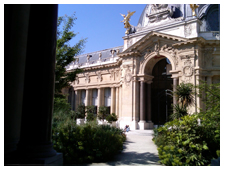 | | The Petit Palais in Paris |
What a surprise we had. Just when we thought we'd managed to see at least most of the major museums in Paris, a new one enchanted us. It's not new. The Petit Palais, along with the Grand Palais, was built for the 1900 World's Fair. The Petit Palais has housed the city of light's municipal art collections since 1902. Crossing the Alexandre III Bridge from the Left Bank to the Right takes you to both of these gems. We could only peep in the windows of the Grand Palais, but walked across the street up the grand stairs into the Petit Palais - one of 15 free Paris museums. Since its renovation in 2005, it has housed primarily a collection of paintings and decorative arts from the late 19th and early 20th centuries. The enormous main room features glass by Emile Gallé, and other artists from the Art Nouveau period. Farther on you will see some large works by Courbet, as well as a Pissarro and Monet. There is also a Louis XV room with furniture. But the "aha" moment is the courtyard - the building encircles it, and it glows with gilt adornments, plantings and a fountain and pool. This is a real oasis in the heart of Paris. Reasonably priced self-service food is available including salads, sandwiches and, of course, wine. Then you can enjoy your meal at a table and chair in a splendid shady courtyard, or eat inside if it's raining.
An interesting note from Susan Leidy about the Petit Palais. There are seven 15th and 16th century Flemish paintings as well as an Italian Renaissance Madonna and Child that could or should be in New Hampshire. Edward Tuck (1842-1938), who donated this art to the city of Paris, was a New Hampshire native, born in Exeter. Tuck and his father attended Dartmouth University, and to honor his father, Edward donated funds to build the Amos Tuck School of Administration and Finance. Edward was vice consul to Paris appointed by President Lincoln, whose son, Robert Todd Lincoln, was a student at Phillips Exeter Academy and who knew Amos Tuck.
Petit Palais
Musée des Beaux-Arts de la Ville de Paris Avenue Winston Churchill 75008 Paris 01-53-43-40-00 www.petitpalais.paris.fr Open every day from 10 a.m. to 6 p.m. except Mondays and holidays. Open Thursdays until 8 p.m. for special temporary exhibitions. - by Ted and Pam Parrot Contact Judy McKenna or Peeps Bogaert and tell us about a museum you have visited that is worth the trip. |
|
|
|
|
|
|